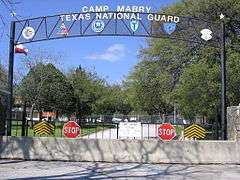Camp Mabry
|
Camp Mabry Historic District | |
|
Post-9/11 Entrance to Camp Mabry | |
 | |
| Location |
2210 W. 35th St Austin, Texas United States |
|---|---|
| Area | 375 acres (152 ha) |
| Built | 1892 |
| Architectural style | International Style, rustic CCC |
| NRHP Reference # | 96000967[1] |
| Added to NRHP | 30 August 1996 |
Camp Mabry (ICAO: KATT) is a military installation in Austin, Texas that houses the headquarters of the Texas Military Forces and the Texas Military Forces Museum. Established in 1892, Camp Mabry is the third-oldest active military installation in Texas, behind Fort Sam Houston and Fort Bliss. It was named for Brigadier General Woodford H. Mabry, the Adjutant General of Texas when the camp was founded.[2] The camp was added to the National Register of Historic Places in 1996.
Military functions
Camp Mabry is the home to the Joint Force Headquarters of the Texas Military Forces, housing the office of the state adjutant general and the headquarters of the Texas Army National Guard, the Texas Air National Guard, and the Texas State Guard. It also hosts the Texas Military Forces Museum.
The facility has served a variety of military purposes since its establishment. It was used as a mobilization area during the Spanish–American War, as headquarters for the Texas Defense Guard during World War II, and as a training facility for the Texas DPS and the Texas Rangers until 1953. It has also hosted the Texas National Guard's State Officer Candidate School since 1959.[3] Camp Mabry currently hosts tenant units from the U.S. Army Reserve and the U.S. Marine Corps Reserve.
Site
Camp Mabry's original 85-acre (34 ha) site, overlooking the Colorado River three miles (5 km) northwest of downtown Austin, was donated by the city to the state in 1892. It was initially a literal "camp," a space in which the Texas Volunteer Guard encamped during the summers while hosting mock battles and demonstrations for the people of Austin. In 1909 the camp was greatly enlarged by the addition of 200 acres (81 ha) of land purchased by the federal government for use in training the state national guard. Other land gifts brought the camp to its present size of around 375 acres (152 ha) by 1911.[3] The site now adjoins the west side of Mopac Expressway.
Facilities
The first constructions at the camp were grandstands and a mess shed, funded by paid admissions to the historical reenactments and events held there. In 1915 an arsenal became the first permanent structure built onsite, allowing military equipment and weapons to be moved out of storage in the capitol building.[2] During World War I the U.S. Army used the camp as a training site and built several barracks and administration buildings. Other facilities include the 136th Regional Training Institute, state Combined Support Maintenance Shops, the armory of the 36th Infantry Division headquarters, a clinic, a parachute packing and storage facility, and additional storage buildings. In 1992 the Texas Military Forces Museum opened on the site.
Prior to the September 11th attacks, Camp Mabry's mile-long track that sits adjacent to Mopac was a popular destination for walkers and joggers, and the field within it was used by many youth sports teams. The track and field are still available for public use, though adult visitors must present a state or federal ID at the gate.
Weather station
Camp Mabry has also operated an ICAO recognized weather station since 1898.[4]
References
- ↑ National Park Service (2010-07-09). "National Register Information System". National Register of Historic Places. National Park Service.
- 1 2 "A brief history of Camp Mabry". Texas Military Forces Museum. Retrieved 8 April 2015.
- 1 2 Smyrl, Vivian Elizabeth. "CAMP MABRY". Handbook of Texas Online. Retrieved 8 April 2015.
- ↑ "Camp Mabry Austin City Airport". Airport Distance Calculator. Retrieved 8 April 2015.
Coordinates: 30°19′07″N 97°45′41″W / 30.3185°N 97.7614°W


